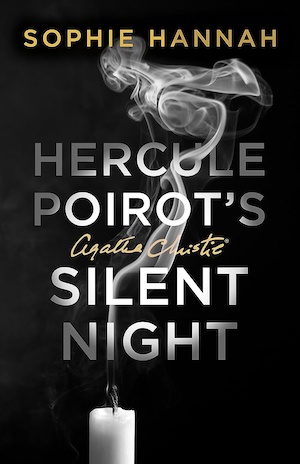Is there any better gift for mystery fans than the return of the Christie for Christmas? Of course, Dame Agatha herself can’t be expected to visit from the great beyond with a fresh manuscript in hand but Sophie Hannah has donned her literary Santa suit and delivered the perfect present in Hercule Poirot’s Silent Night.
Continuing her revival of the iconic detective and paying tribute to Christie’s fondness for seasonal sleuthing, Hannah presents an absorbing murder mystery set against the bucolic background of rural Norfolk in 1931. She seamlessly captures the essence of Christie’s intricate plotting and extends the Poirot mythos with a richly complex story that effortlessly combines elements of the classic country house mystery with a deceptively festive ambiance.
Inspector Edward Catchpool is looking forward to his annual leave from Scotland Yard and to spending a relaxing and no doubt decadent Christmas with good friend Hercule Poirot. Unfortunately, his overbearing mother, Cynthia, has other ideas. Bursting into Poirot’s flat on the evening of 19 December, she explains that she has been staying with the Lauriers, old family friends, at Frellingsloe House outside the Norfolk market town of Munby-on-Sea.
Arnold Laurier has a terminal illness and is intending to spend a final Christmas at home before moving into St Walstan’s Cottage Hospital in the new year. It might sound a bit grim, but Arnold is buoyed by the fact that there has recently been a murder at the hospital, one that he plans to spend his final days solving. By contrast, his wife, Vivienne, is distraught and convinced that Arnold is now destined to become the killer’s second victim.
With the atmosphere of the house party fraught and Vivienne quickly becoming a shadow of her former self, Cynthia has decided that Poirot and Catchpool must spend Christmas at Frellingsloe House and ensure that the killer is caught before Arnold moves into the hospital. It doesn’t sound like the ideal holiday destination, but Cynthia’s forceful personality means that the pair are on the train to Norfolk before they have time to think of a decent excuse.
Through Cynthia’s sudden intrusion into the genteel Christmas planning of Poirot and Catchpool, as well as her garbled explanation of the problem she wants them to solve, Hannah adeptly sets the stage for the mystery, immediately unveiling a world of suspicion and hidden motives. What ensues is a meticulously crafted web of familial tensions and complex relationships that provide the perfect breeding ground for murder.
Hannah exhibits a finely tuned ability to stay true to the quintessential Christie style while also incorporating her own unique brand of storytelling. Hercule Poirot’s Silent Night is infused with a nostalgic atmosphere, recalling the glory days of Poirot and Captain Hastings as they visited stately pile after stately pile, solving fiendish mysteries from dawn to dusk. Within the classic whodunnit structure, Hannah builds an intricately layered mystery, gradually revealing clues and introducing red herrings.
As the investigation proceeds, the suspense and tension quietly build, and Hannah’s canny misdirections consistently muddle perceptions and confound expectations. The deliberate pacing of the story, while sometimes a tad vexing, particularly during Catchpool’s tree-decorating exploits, effectively contributes to the idea of pressure building within Frellingsloe House. It also allows for the gradual unfolding of the mystery in a way that reflects Poirot’s signature sleuthing style.
Hannah’s attention to detail and meticulous world-building are evident throughout. Munby-on-Sea is exactly the kind of place where an Agatha Christie mystery would unfold, but it’s also a realistic and vital 1930s town. What’s more, Hannah subverts the image of the archetypal country house by having Frellingsloe House be subject to disastrous coastal erosion. The fact that the house is destined to disappear into the sea is reflective of both the crumbling of former upper-crust society and the fragility of the Laurier family in particular.
Hercule Poirot’s Silent Night also offers a captivating exploration of family dynamics and human psychology, issues that have traditionally engrossed Poirot’s little grey cells. The existence of familial discord and hidden resentments highlights how strife can fester in even seemingly idyllic settings. Cracking the case necessitates delving into the depths of human emotions and wading through relationships strained by secrecy and betrayal, ultimately arriving at Poirot’s hallmark dénouement.
While he can’t quite match the charm of Hastings, Catchpool’s thoughtful nature and doggedness perfectly balance Poirot’s flamboyance and enigmatic nature. Poirot’s eccentricities and brilliant deductions certainly still take centre stage, but Catchpool serves as a well fleshed out investigator in his own right. The interplay between the two characters reveals a mutually beneficial partnership founded on comradery, respect and an unquenchable desire to bring murderers to justice.
Hercule Poirot’s Silent Night is a great addition to the Poirot canon, blending the charm of Christie’s classic approach to the murder mystery with Hannah’s gift for misdirection and psychologically sound reasoning. With its myriad clues, motives and suspects, it offers a welcome return to the world of Hercule Poirot.
Also see Janice Hallet’s The Christmas Appeal and Peter Swanson’s The Christmas Guest.
HarperCollins
Print/Kindle/iBook
£18.99
CFL Rating: 5 Stars
Using these associate/affiliate links helps support our site.
